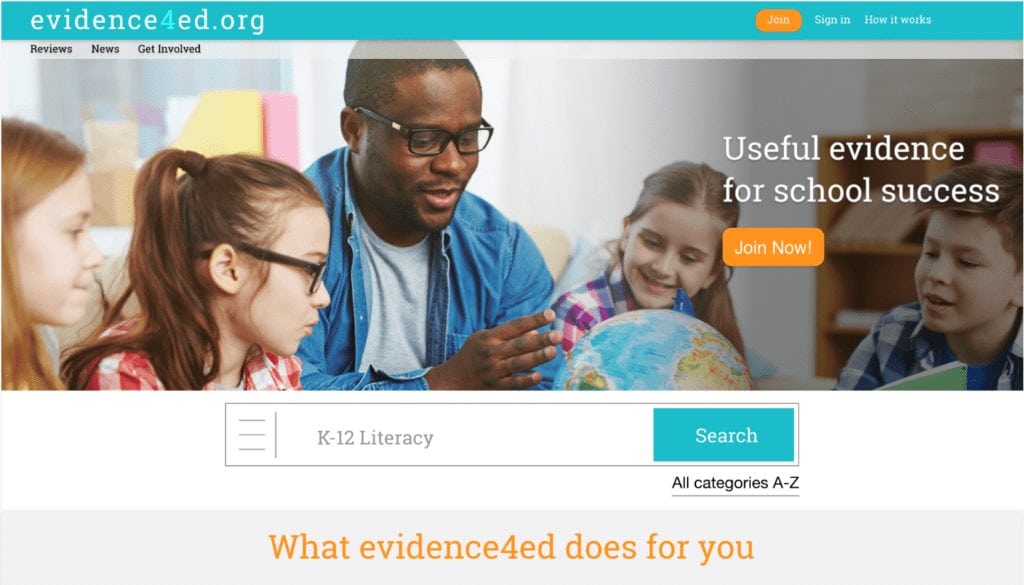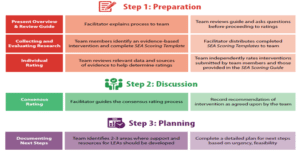For the final post of our eight-part “Using Research Evidence Under ESSA” blog series, Laurie Lee shares resources developed by the Florida Center for Reading Research, and Steve Fleischman discusses Evidence4Ed, an online tool currently being developed.
Laurie Lee:
The Every Student Succeeds Act (ESSA) emphasizes the importance of implementing evidence-based interventions in schools – particularly in those schools in need of improvement. That said, how do state or local education agencies know which interventions will be most effective in THEIR schools? We know that schools are required to conduct a needs assessment if they are identified under ESSA for comprehensive or targeted support. That should help state and local education agencies to match the appropriate evidence-based intervention to a particular school, but who ultimately makes the decision regarding which interventions to implement?
ESSA allows state education agencies (SEAs) to develop a list of interventions from which schools can choose if they so desire, or the SEA may offer flexibility to those at the local level to make their own independent decisions. In any case, local education agencies (LEAs) and SEAs must approve school improvement plans for those schools in need of comprehensive support, and LEAs must approve school improvement plans for schools in need of targeted support. Hopefully, diverse teams comprised of knowledgeable staff with a variety of roles will make decisions regarding the selection of evidence-based interventions, keeping the needs of the school at the forefront of their thinking.
Last fall, the William T. Grant Foundation, the Annie E. Casey Foundation and the Overdeck Family Foundation provided funding to the Florida Center for Reading Research at Florida State University to publish two self-study guides. The purpose of the guides is to help SEA and LEA teams identify evidence-based practices that might address the needs of their schools most appropriately. The SEA Guide for Identifying Evidence-Based Interventions for School Improvement and the LEA Guide for Identifying Evidence-Based Interventions for School Improvement provide tools for diverse teams to engage in preparation, discussion, and planning as they identify evidence-based interventions for use in schools.
As the self-study process begins, team members and a facilitator are selected. A wide variety of staff are included representing diverse roles. Each team member initially works individually to collect and review research related to an intervention, to propose an intervention to their team, and then review and rate example interventions included in the guide as “not recommended,” “recommended,” or “strongly recommended.” This is preparation for the discussion phase of the self-study.
The team then comes together to talk about the various interventions that have been proposed and rated to consider them in conjunction with the needs assessments conducted by schools. Many factors may be discussed by the team, such as the strength of the evidence-base according to ESSA, the capacity of the school to implement the intervention, the needs of the school, and the ability of the school to sustain the intervention. Ultimately, a consensus is reached regarding the selection of evidence-based interventions that seem best for schools.
The discussion then turns to planning. The team completes a planning form which helps them to consider resources that the school already has, the support that might be needed, etc. The goal is to ensure, as much as possible, that the school will be able to implement the intervention effectively.
The figure below provides a synopsis of the self-study process:
Whereas a number of resources provide lists of evidence-based interventions for schools, the intent of the self-study guides is to provide a structured process so that teams consisting of members with a variety of perspectives may select interventions collaboratively and thoughtfully, and also to focus on how to help ensure implementation is successful and sustained.
The SEA Guide for Identifying Evidence-Based Interventions for School Improvement and the LEA Guide for Identifying Evidence-Based Interventions for School Improvement along with other ESSA resources may be accessed at: http://fcrr.org/essa.
A “Rotten Tomatoes” for Education?
Steve Fleischman
Some of us like action movies. Others prefer comedies or dramas. However, one thing that we have in common is that when we choose a movie, we want it to be “good.” Not long ago, we found out about good movies from the recommendations of friends, family, and colleagues—or by reading reviews in our local papers. That has totally changed with the advent of the web and social media.
My guess is many of you now check websites like Rotten Tomatoes to help you decide which movies to see. If you go to that site, you get side-by-side information on what percentage of all movie critics and viewers—just like you—liked a movie. This now puts you in a great position to decide whether the movie may be worth seeing or not.
If you are a state leader trying to help educators choose a school improvement approach to use, what comparable tool could you suggest they turn to support their decisions? Likely none, since no such tool currently exists. However, with the support of the William T. Grant and Overdeck Family Foundations, a team from Education Northwest is working on creating exactly this type of website and service. We call it Evidence4Ed, and hope to launch it by the end of this year.
 Evidence4Ed will partner with educators to create an easy-to-use, online tool that helps sort through improvement options. It will combine the thousands of research reviews and ratings of improvement approaches provided by more than a dozen “evidence clearinghouses,” such as the What Works Clearinghouse or Blueprints for Healthy Youth Development, with the opinions of educators who are currently using those approaches.
Evidence4Ed will partner with educators to create an easy-to-use, online tool that helps sort through improvement options. It will combine the thousands of research reviews and ratings of improvement approaches provided by more than a dozen “evidence clearinghouses,” such as the What Works Clearinghouse or Blueprints for Healthy Youth Development, with the opinions of educators who are currently using those approaches.
Good decisions result from matching the unique needs of students, schools, districts and communities with the best available improvement options. This requires giving decision makers the “whole picture” about an improvement approach, not just the evidence of its effectiveness. Decisionmakers also want to know answers to questions such as: Is the approach hard or easy to use? How good is the support that you receive to use it? Would you recommend this approach to other schools and districts? This is the information they will get when the log on to Evidence4Ed.
I look forward to updating you on our progress through future AYPF blogs. Please contact me at Steve.Fleischman@educationnorthwest.org to let me know how Evidence4Ed can help meet your decisionmaking needs.









